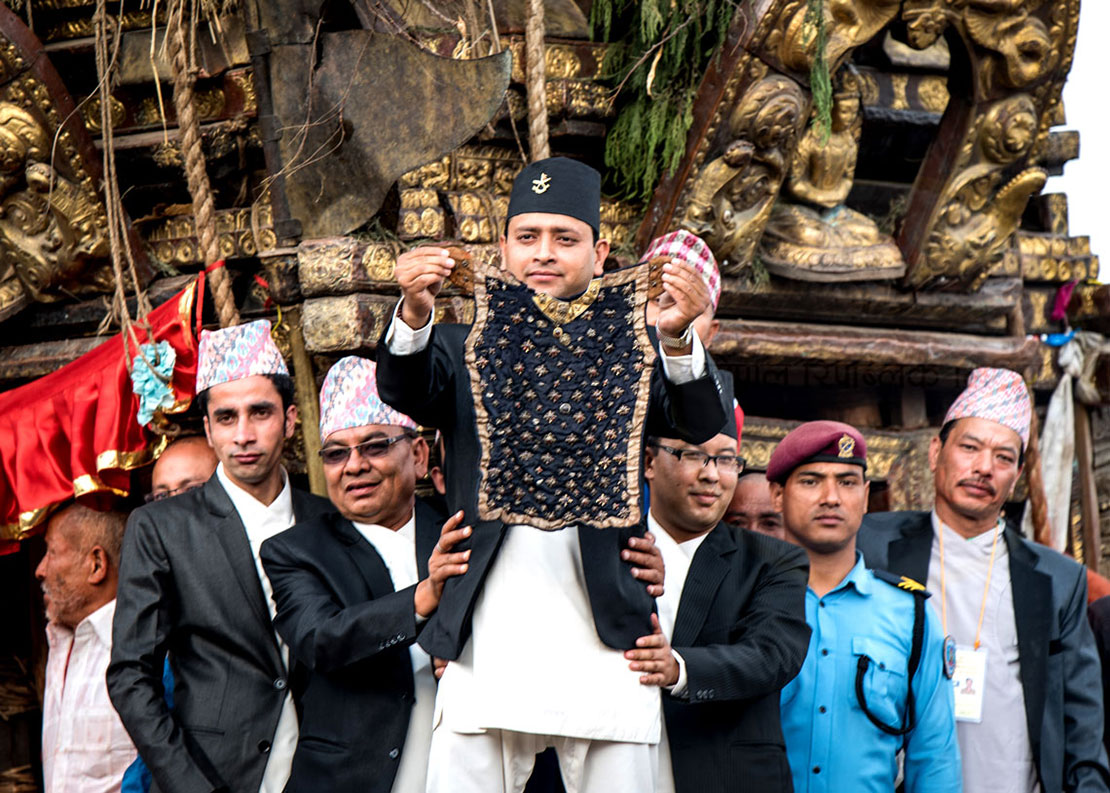

What is Bhoto Jatra?
To grasp the true meaning of Bhoto Jatra, one must first understand the words themselves: Bhoto refers to a traditional Nepali vest, and Jatra means festival or procession. Quite literally, it is a festival of the vest—but not just any vest. This isn’t a celebration of ordinary clothing, but of a jeweled garment deeply embedded in Nepal’s cultural memory, shrouded in myth, and displayed ceremonially only once a year.
At first glance, it may seem peculiar—why would thousands gather to witness a vest being raised high from a chariot in a city square? But as with many festivals in Nepal, this spectacle is rooted in a profound narrative, one involving gods, serpents, drought, divine teachers, and a long-lost treasure.
A Month of Devotion: The Rato Machhindranath Jatra
Bhoto Jatra serves as the grand finale of the Rato Machhindranath Jatra, a month-long chariot festival held in Patan, the ancient city of artisans and temples. This revered event honors Rato Machhindranath, a rain deity venerated by both Hindus and Buddhists. Known locally as Bunga Dyah, this red-faced god is believed to bless the Valley with abundant rains and good harvests.
The festival begins in the month of Bachhala (usually May or June), when priests ceremonially transfer the image of Rato Machhindranath from his temple in Tabahal, Patan, to a towering 60-foot-high wooden chariot. The chariot itself is a feat of engineering and devotion, constructed with bamboo scaffolding and ropes, and raised with community effort at Pulchowk.
Over the next several weeks, the chariot is hauled by hundreds of devotees through the narrow alleys of Patan, making stops at Gabahal, Sundhara, and Lagankhel, before finally reaching its resting place at Jawalakhel. It is here, before dignitaries and crowds, that the climax of the festival—Bhoto Jatra—unfolds.
The Unusual Tale Behind the Vest
The origin of Bhoto Jatra is tied to a folk story passed down through generations. The most widely accepted version begins with Karkotaka Naga, a serpent deity believed to reside in the waters of Taudaha, on the outskirts of Kathmandu.
According to legend, Karkotaka’s wife once suffered from a painful eye disease that no healer could cure. A humble Jyapu farmer—part of the Newar agricultural caste—offered a cure. Using the oil and dirt from his body, he rubbed her eyes, and miraculously, she was healed. As a token of gratitude, the Naga presented the farmer with a jeweled Bhoto, a precious vest studded with diamonds.
Proud of his gift, the farmer wore the Bhoto regularly. But tragedy struck one day while he was transplanting rice seedlings. He removed the vest and placed it nearby. Suddenly, a Lakhe, a demon-like figure from Newar folklore, appeared and snatched it. The farmer gave chase but the Lakhe vanished without a trace.
Months later, while attending the Machhindranath chariot procession in Jawalakhel, the farmer spotted the same Lakhe wearing the stolen Bhoto. A confrontation ensued, but neither could produce evidence of ownership. The matter was brought before the king, who, seeing no resolution, entrusted the Bhoto to Rato Machhindranath himself, declaring it would be displayed each year until a rightful claimant emerged with proof.
Rain, Serpents, and Saints: The Deeper Mythology
Another deeper myth explains the very existence of Rato Machhindranath Jatra. Centuries ago, the Kathmandu Valley was suffering a terrible drought. Rain had ceased for years, crops withered, and people began to starve.
Astrologers traced the cause to Guru Gorakhnath, a powerful yogi who had come to Patan seeking alms. Offended by the townspeople’s refusal to offer him food, Gorakhnath captured all the rain-bringing Nagas and sat on them in meditation, effectively blocking rainfall.
Desperate, the king—Narendra Dev, a Lichhavi ruler—consulted priests and was advised to invite Machhindranath, the guru of Gorakhnath, from Assam (India). When Machhindranath arrived, Gorakhnath stood up to greet his revered teacher, inadvertently freeing the serpents. Rain returned to the valley. As gratitude, King Narendra Dev began the annual chariot procession in honor of Rato Machhindranath—a festival that has continued for over a millennium.
The Display at Jawalakhel: Ritual, Politics, and Faith
The final day of the chariot procession marks Bhoto Jatra, where the sacred vest is publicly displayed from the chariot platform in Jawalakhel. Held on an auspicious day selected by astrologers, the ritual is a solemn yet festive occasion. Senior priests, dressed in ceremonial attire, climb the chariot and raise the Bhoto in all four cardinal directions, symbolizing openness, trust, and unresolved ownership.
This event is not just a religious ritual—it carries significant cultural and political weight. High-ranking government officials, including the President, Prime Minister, and Cabinet Ministers, attend the ceremony, making it one of the few festivals in Nepal that blends ancient spiritual tradition with the authority of the modern state.
The Legacy of Bhoto Jatra in Visit Nepal
In recent years, Bhoto Jatra has also gained attention as a cultural spectacle for international visitors, aligning well with tourism campaigns such as Visit Nepal Year. Tourists from around the world marvel at the towering chariot, the throngs of devotees, and the mysterious vest that remains unclaimed for centuries.
Despite modernization, the festival remains a powerful reminder of Nepal’s living heritage, where myth, ritual, and civic participation continue to co-exist. The image of the glimmering Bhoto, held high under the open sky, is more than just a vest—it is a symbol of unresolved justice, divine intervention, and the collective memory of a people shaped by gods, serpents, and rain.
Travel Tips: Experiencing Bhoto Jatra as a Visitor
If you’re planning to witness Bhoto Jatra in person, here are some practical tips to make the most of your visit: